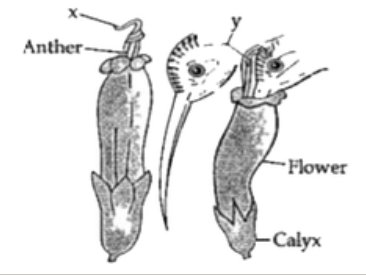Tulip flowers shows
Photonasty
Thermonasty
Thigmonasty
Hydronasty
The correct Answer is:B
Step-by-Step Solution:
1. Understanding the Question: The question asks about the type of movement exhibited by tulip flowers. The options provided are photonasty, thermonasty, thigmonasty, and hydronasty.
2. Defining Nastic Movements: Nastic movements are plant movements that occur in response to stimuli, but they are not dependent on the direction of the stimulus. They can be classified based on the type of stimulus.
3. Analyzing the Options:
- Photonasty: This refers to movements in response to light. For example, flowers that open or close based on light availability.
- Thermonasty: This refers to movements in response to temperature changes. For example, flowers that open in warm temperatures and close in cooler temperatures.
- Thigmonasty: This refers to movements in response to touch or mechanical stimulation. An example would be the closing of a Venus flytrap when it is touched.
- Hydronasty: This refers to movements in response to water availability.
4. Identifying the Correct Response for Tulip Flowers: Tulip flowers open and close in response to temperature changes. They tend to open when the temperature is high and close when the temperature is low. This indicates that their movement is a response to temperature, which is defined as thermonasty.
5. Conclusion: Based on the analysis, the correct answer is thermonasty.
Final Answer:
Thermonasty (Option B) is the correct choice for the type of movement exhibited by tulip flowers.
---
- Photonasty: This refers to movements in response to light. For example, flowers that open or close based on light availability.
- Thermonasty: This refers to movements in response to temperature changes. For example, flowers that open in warm temperatures and close in cooler temperatures.
- Thigmonasty: This refers to movements in response to touch or mechanical stimulation. An example would be the closing of a Venus flytrap when it is touched.
- Hydronasty: This refers to movements in response to water availability.
Thermonasty (Option B) is the correct choice for the type of movement exhibited by tulip flowers.
Topper's Solved these Questions
- ENVIRONMENTAL ISSUESBOOK - DINESH PUBLICATION ENGLISHCHAPTER - ENVIRONMENTAL ISSUESEXERCISE - Model test paper-5
100 Videos
- ENVIRONMENTAL ISSUESBOOK - DINESH PUBLICATION ENGLISHCHAPTER - ENVIRONMENTAL ISSUESEXERCISE - Model test paper-3
100 Videos
- ECHINODERMATABOOK - DINESH PUBLICATION ENGLISHCHAPTER - ECHINODERMATAEXERCISE - REVISION QUESTIONS
65 Videos
- EVIDENCES OF EVOLUTIONBOOK - DINESH PUBLICATION ENGLISHCHAPTER - EVIDENCES OF EVOLUTIONEXERCISE - CHECK YOUR GRASP
19 Videos
Similar Questions
Why are some plants having bisexual flowers show self incompatibility?
View SolutionWhich flower shows nyctinastic movement ?
View SolutionFlowers of Ophrys resembles female wasp Colpa and are pollinated by male wasp. The flowers show mimicry
View SolutionA pea plant with purple flowers was crossed with white flowers producing 60 plants with only purple flowers.
On selfing, these plants produced 482 plants with purple flowers and 162 with white flowers. What gametic mechanism accounts for these results.
View SolutionWhich type of movement is shown by Tulip and Sunflower respectively ?
View SolutionViroid causes
(a) Cauliflower mosaic
(b) Potato spindle mosaic
(c) Tobacco mosaic
(d) Tulip yellow mosaic.
View SolutionDraw a well-labelled diagram of L.S of a pistil of a flower showing the passage of growing of pollen tube up its destination
View SolutionGiven below is a diagram depicting a physiological process in plants.
Study the same and answer the following questions :

Write two adaptations of flowers showing this process.
View SolutionHow many of the given plants have actinomorphic flowers?
Radish, Tulip, Ashwagandha, Wheat, Lupin, Cassia, Canna, Asparagus, Datura, Mustard, Chilli, Tobbaco
View SolutionHow many of the following plants belong to a family whose flowers have six tepals and six epitepalous stamens ?
[Colchicine, Aloe, gram, potato, Gloriosa, tomato, sweet pea, Asparagus, groundnut, tulip]
View Solution
